This blog is the final part of a series that began in November of 2021 to chronicle the journey of building a trauma-informed school at Loper Elementary School in Shelbyville, IN. The previous parts of the series focused on these building blocks of creating a trauma-informed school:
- Mindsets and components
- Knowledge, opportunities, allies, and experiences, and
- Bumps, roadblocks, and detours along the way
This part of the blog will focus on the impact of a trauma-informed school.
“Just as the ripples spread out from the drop of a pebble in a pond, you will see your program grow as your staff tries out new interventions and applies the information provided to them.”
As you build the knowledge and experiential base for your program, you will notice a ripple effect. Just as the ripples spread out from the drop of a pebble in a pond, you will see your program grow as your staff tries out new interventions and applies the information provided to them. You may notice teachers talking in a different way. For example, some conversations heard at Loper this school are
- “I wonder what has happened to her.”
- “He’s been through a lot.”
- “He was so dysregulated. I asked if I could hold his hand. Once I touched his hand, he immediately became more regulated and then we could talk.”
- “After transitioning from reading to math, I just take out the breathing ball and shut out the lights and we breathe together. The students immediately settle down and I do, too.”
You may see interactions changing:
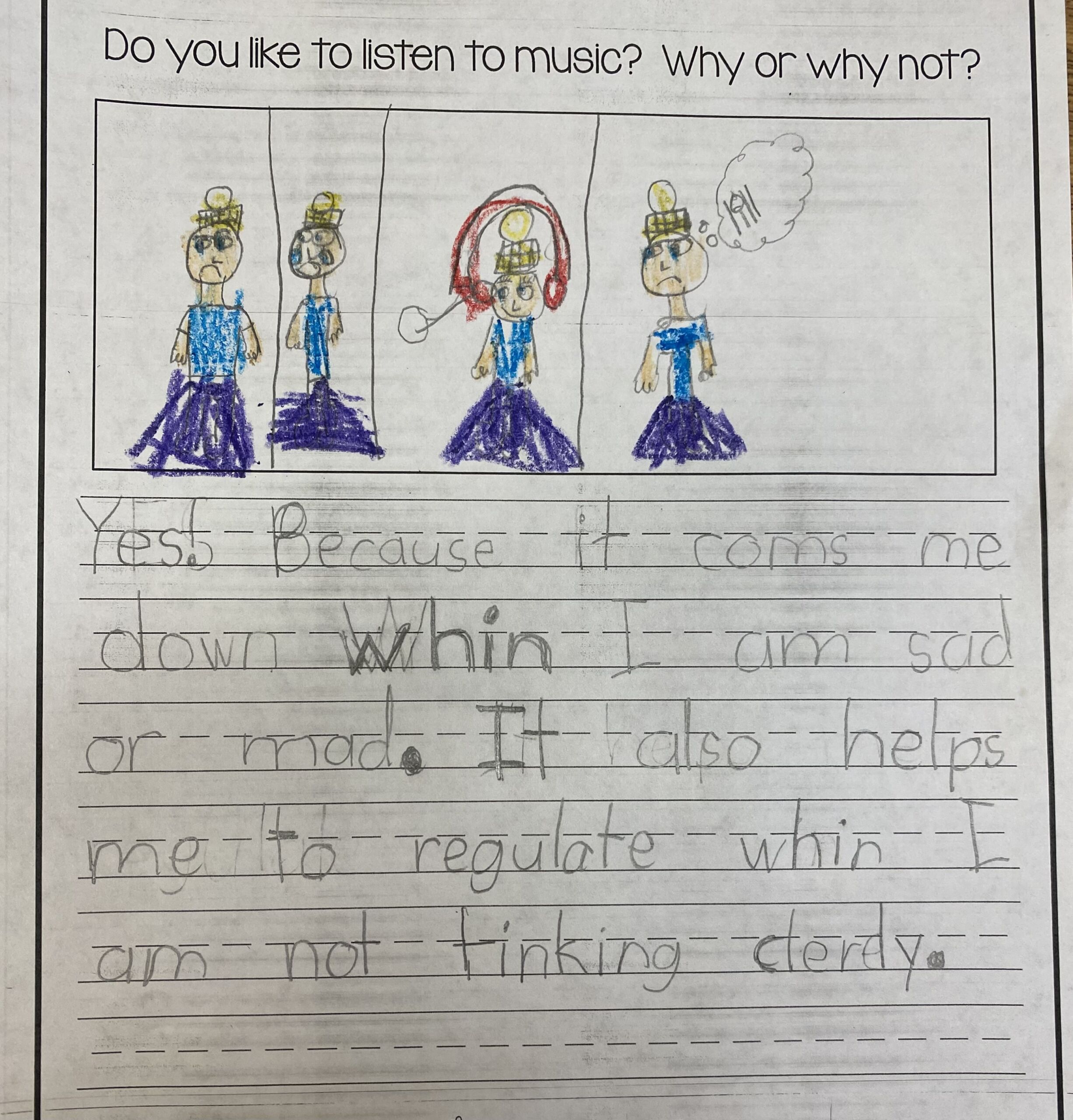
- A principal sitting with a dysregulated student, talking calming until the student becomes regulated.
- Teachers talking to students about feelings when they notice the student is starting to experience distress.
- Teachers becoming more flexible about what they expect from a student based upon his or her needs. For example, at Loper, some students have a pass that they can be by themselves in the hallway so that they can go on a short walk around the school to be calmer and a fourth grader carries a stuffed animal with him everywhere he goes throughout the school day in order to stay more regulated.
- Teachers incorporating SEL into their curriculum. This might look like this: including a character’s feelings and thoughts into discussion of reading materials, making assignments about the social-emotional aspects of the reading, such as writing an acrostic poem with the letters of empathy, or having a writing station focusing on ways to regulate.
You may notice students interacting in a different way:
- During a group meeting to discuss the loss of a loved one, a student said, “Wait a minute. I need to regulate myself.” After she did the “magic mustache” calming technique, she said, “Ok. I’m regulated now.” She was then able to proceed with the group work. This student’s teacher leads at least two calming activities a day in her classroom.
- By using Zones of Regulation, students saying to other students, “I think you’re in the red zone. Can I help?” Or students letting teachers know when they see other students in the red zone.
One of the most powerful interventions that your school will benefit from is implementing community circles. Within a few weeks of starting this part of the program, both students and teachers will benefit. Teachers at Loper have shared these experiences about morning meetings:
- “Every year I like my students. But now that we have morning meetings, I REALLY like my students!”

- “Morning meeting is my favorite part of the day.”
- “I can’t imagine teaching without morning meetings.”
- “My students are starting to care about each other.”
- “Morning meetings have been wonderful! I have been very surprised by how much I have come to love it. I feel closer to my students than I probably ever have.”
- “Students look forward to it everyday! It has helped students feel open enough to share feelings.”
- “My class really, truly feels like a family.”
- “Students and I love the meetings. Students are a little more patient with each other. They are reminding each other about breathing.”
- “My kids look forward to morning meetings. It helps build community and allows for everyone to let go and be ready for the day.”
Relationships are the foundation of all trauma-informed schools programs. The ripple effect may also spread to staff using the knowledge in their own lives or with members of their team. Some examples of this are:
- After the PD on trauma, two teachers had their mothers complete the ACE study survey, because they knew they had experienced a lot of trauma. From these discussions, the teachers learned so much about their mothers, their families, and about themselves. They have been better able to apply their deeper understanding of trauma with their students.
- Another teacher shared the ACE study with one of her teaching assistants who struggled to have enough patience with their students. The teacher knew that the assistant had experienced a lot of trauma. From these discussions, the assistant grew in her understanding of the students, developed more patience, and was even able to apply the concepts to her own parenting.

In time, another impact of trauma-informed practices will become visible: incidences of office referrals and suspensions will drop. It takes four years to build a trauma-informed school program, so it will not have an immediate impact. However, as with the other components of the impact, you will see the ripple effect with discipline, too. Since Loper is only in its second year of building its program, I have included data from my previous school, Central Elementary, in Beech Grove, IN, to show the impact of these types of practices on discipline. (Since some of these years were during Covid and the school was shut down in March of 2020, the statistics cover just the months of July to March in order to keep the data consistent across the school years.)
Office Referrals 17-18 to 20-21

Suspensions 17-18 to 20-21
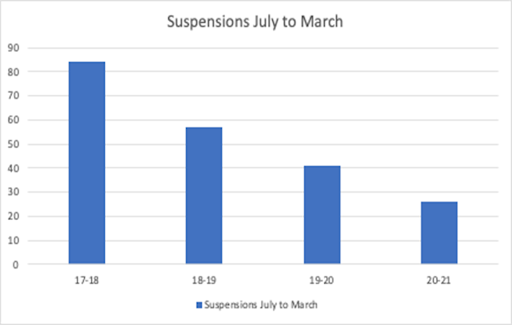
Bus Write-Ups 17-18 to 20-21
At Central Elementary, we also saw an impact in areas that we did not expect.
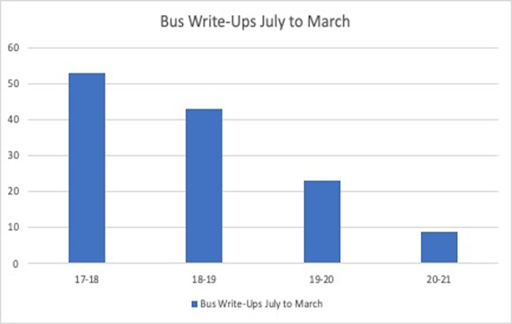
Perceptions of Being Bullied
At Central, we had studied perceptions of 3rd graders being bullied since 2012. There was no change from 2012 to 2018. Once community circles were implemented, we saw an impact.
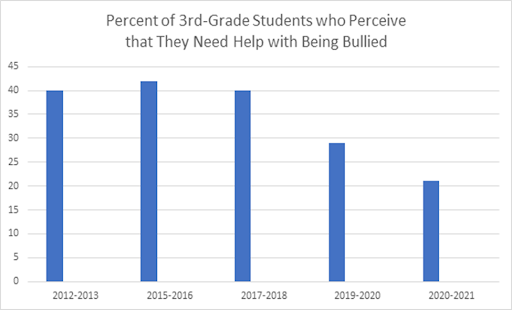
Students’ Perceptions of Having a Good Relationship with their Teacher
At Central, we knew that our teachers were having difficulty connecting with students of color. Although we saw a huge jump in all students viewing their relationship with their teacher positively, we were most pleased by seeing that we were making a difference in connecting with our Black students. (The data for Latino students is not available for 2017 due to the number of Latino students being too small to show up in the data that year.)
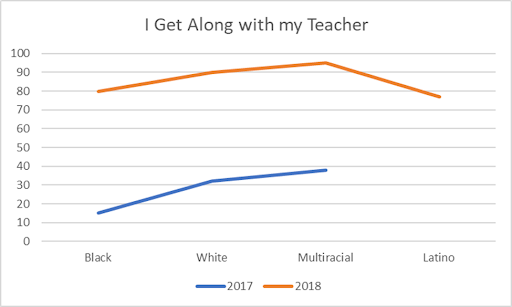
Is it hard to work to develop a trauma-informed school? Yes, it is. It will take devotion, time, energy, patience, team work, resilience, and so much more. Will it be worth it? Most definitely! Once your program is built, it will also take continued work and resources. Professional development must continue for all staff. You will need to find a path to train new staff as they come on board. It will be necessary to continue to monitor progress, adjust your plans, and stay diligent in reaching your goals.
It is important to keep these things in mind as you build, maintain, and grow your program:
- Trust the process, even when it seems like things are moving too slowly.
- Keep up the momentum.
- It’s all about developing a trauma-informed lens and the adults in the building changing.
Thank you for allowing me to share my school’s journey with you. I hope that your school begins its own journey to building a trauma-informed school. And I hope that you appreciate each ripple of impact that you see and develop along the way.
Resources
Please login or register to claim PGPs.
Alternatively, you may use the PGP Request Form if you prefer to not register an account.


